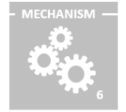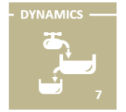Processes - ¨Business Formula¨ 
(A matter of means)

The Processes: what general operations the organization performs.
Defining the Processes of the Business Activity is defining the "Business Formula": determining, for each major process:
- The kind of outputs they produce,
- The value-added they generate,
- The main value generators they use.

Processes are the constituents of the 3 Super-Processes, and can therefore be split in 3 categories:
- Market Processes (inside-out): Value Generation & Delivery (VG&D)
- Capture Processes (outside-in): Value Contracting & Capture (VC&C)
- Industry Processes (inside-in): Value Integration & Maintenance (VI&M)
(click on the following elements for more details)
> Market Processes
(Inside-out Processes: VG&D)
Market Processes aim at fulfilling the targets' relevant needs: they constitute the operational means of acting in the Market Domains.
Market Processes consist in generating and delivering the Value Proposition, in the form of a set of products (goods & services).
Nature of outputs: Outputs are basically what is delivered by the organization to the outside world. For instance:
- Toyota delivers cars, but also accessories, services and warranty to its customers,
- Zynga delivers online games and optional features,
- United Airlines provide transportation services,
- Coca-Cola generates advertizing towards its potential customers,
- KKR sells companies to investors,
- Facebook provides a social platform to its users, and advertizing services to advertisers,
- Verizon issued bonds to finance its expansion,
- Cemex passed through a phase of plants divestment to comply with antitrust regulations.
In a BM perspective, Market Processes' outputs should not be limited to the usual products for sale: it may be relevant to consider the delivery of other types of outputs, when this is part of the usual business operations in a given business phase (like marketing outputs, assets divestments or securities issuance).
Process value-added: The value-added of a Market process is basically the market value of its total output (products) minus the market value of its associated inputs (used supplies and resources). It can also be seen as the extra cash resulting from the existence of the process, compared to a complete outsourced solution where products would be bought from a third party instead of being made by the organization. Looking at Business Functions as BUs, we can indeed consider that the organization could introduce a competitive tender for the production and delivery of its products, instead of using its own Market Function BU: the virtual profit of the Market Function BU based on the theoretical resulting bid prices and quantities (a "market value" for its production and delivery) can be seen as the value-added of the associated Market process.
The value-added in Market processes may constitute a small part or a large part of the output's value:
- software editors and music majors add basically no value to the products they deliver during the Market process (consisting in duplication and delivery of digital goods),
- car dealers or electronic goods resellers add little value to what they deliver to their customers,
- restaurants generate a substantial part of the value they deliver, depending on the level of transformation of raw materials and on the relative importance of services,
- management consulting companies generate most of the value they deliver during Market processes, unless they base part of their recommandations on pre-existing reports.
This has a potential impact on the behavior of the organization's targets. For instance, there is a trend to buy goods or services online when physical resellers do not add much value.
Value generators: The source of value-added can vary a lot depending on the outputs and the processes:
- the value-added from car makers, for the manufacturing and delivery of their vehicles, is the complex result of the use of a good design, the exploitation of productive assembling factories, the use of reliable parts from suppliers, the labor of trained employees and the use of an efficient logistic network,
- value generators for consulting companies, for their Market process, are mostly the quality and quantity of consultants' labor, the expertise and supervision of the management, and the use of efficient methods,
- for the Internet research services that Google proposes to its users, the value generators are mainly the indexation algorythms, the web crawlers (Googlebots), the processing power and storage power of its servers.
When considering value generators for the Market processes, only the "generation and delivery" part of the business activity should be taken into account: the acquisition of supplies are part of Capture processes, and product design is part of Industry processes. As seen in those examples, value generators are usually linked to resources, supplies or activities.
> Capture Processes
(Outside-in Processes: VC&C)
Capture Processes aim at capturing customers' relevant budgets and at acquiring relevant benefits for the organization: they constitute the operational means of acting in the Capture Domains.
Capture Processes consist in contracting with actors of the Value Network, and capturing value through transactions: Revenues on curstomers' side and Supplies on sources' side (in exchange for products and cash).
Although supplies may be acquired not only in exchange of cash, but also for products, and although customers may provide supplies in addition to cash (see Capture Function), it makes sense to consider the two basic modes for Capture, on customers' side ("selling products"), and on sources' side (buying supplies). More complex exchange patterns would be a mix of these 2 basic modes.
CAPTURE ON CUSTOMERS' SIDE:
The Capture Processes, on the customers' side, consist in contracting with customers, and capturing Revenues.
Nature of outputs: The nature of the Capture processes' output, on customers' side, is by definition cash, in exchange for products (goods or services).
For instance:
- Orange gets paid by Virtual Network Operators that used its infrastructure,
- McDonald’s gets paid by restaurant managers for the exploitation of the building and the brand,
- Microsoft gets paid for Office products or for online access to Office 365,
- Rolls-Royce gets paid by airline companies for the use of their engines,
- Ryanair gets subventions from local chambers of commerce where it operates,
- NGOs get donations from individuals or institutions.
Customers may provide other types of value to the organization, on top of cash (information, experience, image etc.). In such a case, customers should also be considered in their role of value sources.
Process value-added: The value-added of a Capture process (on customers' side) is basically the market value of its total output (revenues) minus the market value of its associated inputs (used supplies and resources, and products sold). It can also be seen as the extra cash resulting from the existence of the process, compared to a complete outsourced solution where contracting with customers and capturing revenues would be done by a third party. Looking at Business Functions as BUs, we can indeed consider that the organization could introduce a competitive tender for the selling of its products, instead of using its own Capture Function BU: the virtual profit of the Capture Function BU based on the theoretical resulting bid prices and quantities (a "market value" for products sold) can be seen as the value-added of the associated Capture process.
Depending on the business activity, this value-added can vary:
- Xerox is famous for the efficiency of its sales force, meaning a high level of value-added in the Capture processes,
- hotels usually can't deploy efficient Capture processes internally to rent rooms to individuals. They often outsource part of the Capture processes to specialized web sites (such as Booking.com),
- in the case of commodities traded on free markets, the value-added of the selling process is usually small.
The value-added of a Capture process (on customers' side) is an important factor, as it may shape completely the way the organization sells its products.
Value generators: Value generators can also vary a lot, depending on the industry and on strategic choices:
- for Xerox or Groupon, value generators for their Capture processes are mainly the commercial methods defined by the company, the skills of the trained sales force, and the brand name,
- for Google, a strong value generator for selling ads placement is the AdWords web site, where companies can easily define and purchase their marketing campaigns,
- for Amazon, among value generators are personal data that are supplied by customers themselves, and algorithms to match their profile with products.
Once again, value generators are usually linked to resources, supplies or activities.
CAPTURE ON SOURCES' SIDE:
The Capture Processes, on the sources' side, consist in contracting with sources, and capturing the value associated with Supplies.
Nature of outputs: Outputs of Capture processes, on sources's side, are basically all the supplies (tangible or intangible) coming from Sources outside the organization.
Acquisition of supplies by the organization may be done through cash payment (buying supplies), and/or through the delivery of Products in exchange (services, information, image etc.). In this later case, sources should also be considered in their role of value targets.
For instance:
- United Airlines buys petrol to fuel its aircrafts
- Ford buys parts to build its cars
- Universal Studios hire actors and techniciens to produce movies
- Facebook acquires users' data through its web site
- Century21 acquires rights to sell real estate properties from their owners
- L'Oreal buys its US advertising production from specialied agencies
- Renault rents the "Technocentre" building it uses for its R&D
Process value-added: The value-added of a Capture process (on suppliers' side) is basically the market value of its total output (total supplies) minus the market value of its associated inputs (used supplies,resources and cash). It can also be seen as the extra cash resulting from the existence of the process, compared to a complete outsourced solution where contracting with suppliers and capturing benefits associated with the supplies would be done by a third party. Looking at Business Functions as BUs, we can indeed consider that the organization could introduce a competitive tender for the acquisition of all the benefits required for its processes, instead of using its own Capture Function BU: the virtual profit of the Capture Function BU based on the theoretical resulting bid prices and quantities (a "market value" for total supplies) can be seen as the value-added of the associated Capture process.
Depending on the business activity, this value-added can vary:
- Walmart is famous for its high level of value-added in the Capture processes, through low buying costs,
- Independent grocery stores usually can't deploy efficient Capture processes internally to purchase goods from suppliers. They often outsource part of the Capture processes to central purchasing firms,
- in the case of commodities traded on free markets, the value-added of the buying process is usually small.
The value-added of a Capture process (on suppliers' side) is an important factor, as it may shape completely the way the organization acquire its supplies.
Value generators:
- for Walmart, one value generator is the negociation procedures and skills with suppliers,
- for Facebook, one value generator in their sourcing process for acquiring users' data is the fact that entering data into the web site increases the users' satisfaction, and the fact it is an easy and fun process,
- for McKinsey, one value generator for acquiring talents is the recruitment procedure based on case analysis and multiple interviews.
> Industry Processes
(Inside-in Processes: VI&M)
Industry Processes aim at providing a relevant infrastructure to the organization. They constitute the operational means of acting in the Industry Domains.
Industry Processes consist in integrating and maintaining valuable Resources.
Nature of outputs: Outputs are basically the different resources (new resources or maintained existing resources) that the organization needs for its current or future operations. For instance:
- plants, machines for Ford,
- new product designs for Samsung,
- trained personnel for KPMG,
- pattents for Michelin,
- brand for Coca-Cola,
- consumer-related databases for Facebook,
- procedures for UPS,
- Information system for Cemex.
Process value-added: The value-added of a Industry process is basically the market value of its total output (total resources) minus the market value of its associated inputs (used supplies and resources). It can also be seen as the extra cash resulting from the existence of the process, compared to a complete outsourced solution where integration and maintenance of resources would be done by a third party. Looking at Business Functions as BUs, we can indeed consider that the organization could introduce a competitive tender for the infrastructure required for its processes, instead of using its own Industry Function BU: the virtual profit of the Industry Function BU based on the theoretical resulting bid prices (a "market value" for total resource availability) can be seen as the value-added of the associated Industry process.
Depending on the business activity, this value-added can vary:
- For 20th Century Fox, the film production is a high value-added Industry process, and a non-negligeable part of its performance scheme.
- Airlines usually have poor value-added in the maintenance process of their aircrafts, which is a reason for outsourcing it.
- Intel has a high value-added R&D process, consisting in developping new microprocessors.
- IT infrastructure maintenance is often a low value-added process in many companies, a reason for the recent success of cloud-based solutions.
Value generators:
- In the case of 20th Century Fox, the value-added of the production processes is due to a long experience in this domain, to an efficient usage of studios and equipments, and to a suitable business environment in its location.
- Cemex's value-added process of restructuration of newly acquired cement production sites is due to experience, formal M&A processes and special teams dedicated to this matter.
- Google, in order to ensure efficient storing and maintenance of its huge databases, relies on its own specific data centers.
- Hospitals may make sure their doctors' knowledge is always up-to-date regarding scientific research or new practices, thanks to participation to medical conventions.
Domains < PREVIOUS - NEXT > Objectives









